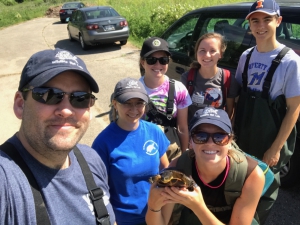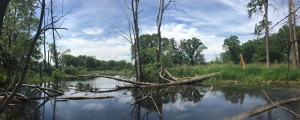
This week was one big roller coaster ride – it was exciting, it took crazy turns and it sadly went by too fast. First-off we have to give a huge shout-out to some of our favorite friends that came to visit and help us: Dr. Matt Allender, Dr. Laura Adamovicz, Marta, Sam, Megan, Kelsey, and Lucas. “Team Vet” took over this week in the field and rocked it in the lab with all these extra helping hands. In three days we were able to tackle our two field sites with advice from our mentors and colleagues; power through our lab work like a steamroller with some tips on how to be more efficient; experience night crew at it’s finest; attempt to extract and save six eggs from Abigail, a gravid female who we unfortunately found deceased while tracking; and even sneak in a trip to Six Flags.
Night Crew and Nesting
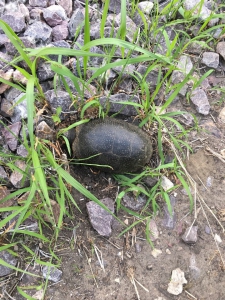
This week we had the opportunity to experience one of the rarest events in nature, the nesting of an endangered species. Wednesday night, after a full day of fieldwork and lab work, Team Vet went out to monitor different nesting sites and mark areas where turtles laid eggs. During nesting season each turtle is tracked at least once daily. Turtles palpated with large and firm eggs whom make big movements and/or direction towards nesting locations are tracked a second time by our night crew to monitor nesting habits. Night crew ventures out just before sunset and determines general location of potential nesting turtles and whether or not they are relatively close to their nesting sites for the evening. We bounce around checking on each turtle throughout the night to see if they have begun to dig a hole to lay their eggs into. When viewing turtles at night we try to be quiet and use a red light filter (which projects light that their eyes can not see) so as not to startle or scare them away from their nesting site.
Wednesday night we had a special treat as THREE turtles nested right in front of us! Ester, Esprit, and Aluna all laid eggs as we were monitoring them. Ester was able to lay 15 eggs! After laying each egg, the turtles use their back legs to move and rotate the eggs in the hole. We suspect this is to make room for more eggs or to allow the eggs to individually get more oxygen. They then carefully cover the holes up with dirt, sometimes taking hours to cover to their eggs. These eggs will remain buried for approximately 60 days until they hatch. Also that night, we hand-captured three females that were trying to lay eggs near our “telemetered turtles” (turtles that we were already monitoring). We put transmitters on these turtles so that we could follow them the next few nights to se-e where they nested. We want the locations of these nests so that we can monitor how many are depredated (destroyed and eaten by raccoons, opossums, or skunks) and how many hatchlings emerge out of the intact nests.
Abigail
Amid all of the excitement this week, we also were forced to deal with the tragic loss of one of our adult females. Abigail, an adult, gravid female that Gary has been tracking for years, was found deceased on the banks of a pond with no obvious signs of trauma. It was decided that she would be taken back to the Univer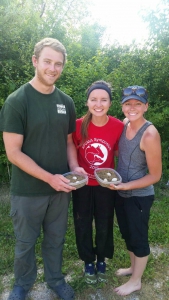 sity of Illinois with Team Vet at the end of the week for necropsy (examination of a deceased animal to determine cause of death; human medicine uses the term autopsy ). However, after a brief physical examination of her body in the field, Lauren noticed that Abigail still had eggs and thought that it may be possible for the eggs to still be viable. With every individual Blanding’s being critical to restoring the population in Illinois, any attempt to save these eggs would be well worth it if even a single one hatched. When we got back to the turtle building, we were able to extract the eggs from Abigail’s uterus through her pre-femoral space. Six eggs were of proper size and shape to have the chance of being viable; typically upon complete development a Blanding’s turtle can carry anywhere between 7-16 eggs. These were removed and placed in vermiculite (a mineral that behaves like soil well suited for incubating eggs), in an incubator where they will remain until they hopefully hatch. Incubation time with a controlled temperature and environment is about 32 days, relative to natural nesting which typically extends to 60 days. Per Dr. Allender and Gary’s examination, two of the eggs currently look like they could contain live embryos – we would be happy with any number being viable! For a somber start to the day, it ended with hope that some of Abigail’s offspring may survive.
sity of Illinois with Team Vet at the end of the week for necropsy (examination of a deceased animal to determine cause of death; human medicine uses the term autopsy ). However, after a brief physical examination of her body in the field, Lauren noticed that Abigail still had eggs and thought that it may be possible for the eggs to still be viable. With every individual Blanding’s being critical to restoring the population in Illinois, any attempt to save these eggs would be well worth it if even a single one hatched. When we got back to the turtle building, we were able to extract the eggs from Abigail’s uterus through her pre-femoral space. Six eggs were of proper size and shape to have the chance of being viable; typically upon complete development a Blanding’s turtle can carry anywhere between 7-16 eggs. These were removed and placed in vermiculite (a mineral that behaves like soil well suited for incubating eggs), in an incubator where they will remain until they hopefully hatch. Incubation time with a controlled temperature and environment is about 32 days, relative to natural nesting which typically extends to 60 days. Per Dr. Allender and Gary’s examination, two of the eggs currently look like they could contain live embryos – we would be happy with any number being viable! For a somber start to the day, it ended with hope that some of Abigail’s offspring may survive.
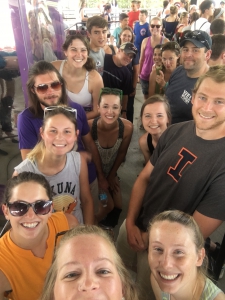
Six Flags
Who would come to Lake County without a trip to Six Flags! We had planned from the beginning of the trip that when our team came up we would take a day to ride some roller coasters and share some laughs – plus who doesn’t want to see their classmates screaming their heads off in a setting outside of exam day. After a long Wednesday filled with day crew, a quick dinner down the street, and night crew, we relieved ourselves from waders and took a trip to Six Flags. We rode over 13 roller coasters (every single one and some of them twice), got dizzy on some spinny rides, and ended with a splash on a water ride. It was a perfect way to spend our last day with Team Vet!
John and Lauren’s High:
The attempt to save Abigail’s offspring was truly a one of a kind experience. Although we are not certain quite yet how many (if any) eggs we have saved, we know we tried every effort to get these developing turtles the best chance at life possible. It was never in our minds that between our blood-draws and DNA swabs we would get the opportunity to attempt to perform a turtle caesarean section and extract eggs from an endangered species. Although it may not result in anything at all we know we gave it our all in the situation we were in to bring some endangered species life into this world. Thanks to Dr. Allender for the quick facetime session during the procedure and the support of of our colleagues that were there that day facilitating and performing the egg extraction. We have high hopes at least one of Abigail’s young will carry on and one day be released back into the wild!
John and Lauren’s Low:
We would have liked to have been able to get more samples when our fellow veterinary mentors and colleagues were visiting. Throughout the whole week we attained a total of 16 samples – the following Monday we attained as many samples as we did the entire week Team Vet was with us. Sometimes we get lucky and get a lot of Blanding’s in our traps, and sometimes we don’t. It might be some skill as to where these traps are placed but it always seems to work out when you think you have them in the worst spots you get the most turtles, and when you think you have them in the best you get nothing but crayfish and tadpoles. We are excited to announce Blanding’s Bowl IV is in the near future (a little friendly competition we will talk about in another blog) where all the skills and all the luck is needed!
